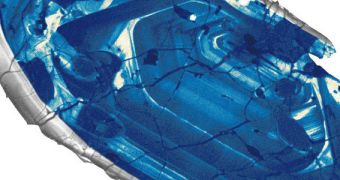Western Australia has just been confirmed as the place where the oldest crystals on Earth lie. A new study has just used an advanced imaging method to confirm that zircon crystal samples collected from this location back in 2001 are indeed 4.4 billion years old, as earlier estimates had suggested.
This value naturally made some researchers doubt its accuracy. In the new study, details of which appear in this week's issue of the top scientific journal Nature Geoscience, researchers at the University of Wisconsin-Madison (UWM) prove that the original claim stands up to scrutiny.
The team, led by geochemist John Valley, used a powerful new technique, called Atom Probe Tomography (APT) or 3D Atom Probe, to look at the zircon crystal samples. Researchers determined that these structures are indeed among the oldest ever to have formed on our planet.
What this investigation basically did was to confirm that the samples collected back in 2001 were formed when our entire planet was less than 150 million years old. In all likelihood, the formation was seeded even before the Late Heavy Bombardment (4.2 to 3.8 billion years ago) began.
“There have been challenges, because nothing in science goes without being questioned. It always has to be proven,” says Valley of the skepticism that met the first team to date the controversial crystals.
If the new study is right, then these structures formed 20 to 80 million years after a massive impact between the early Earth and a Mars-sized object gave birth to the Moon. How these crystals survived a time when our entire planet was turned into a giant ball of molten lava is still a mystery.
“It would have glowed almost like a star. Nothing could exist on the surface. There would be no continental land masses. There'd be no liquid water. And there certainly would have been no life at that time,” Valley explains. The samples appear to suggest that this stage in the development of our planet was short-lived, and that conditions improved soon thereafter.
The minuscule crystals were discovered in limestones at Jack Hills, a sheep ranch in Western Australia. Experts say that these limestones formed an ancient shoreline around 3 billion years ago.
“It's always blown my mind. I mean, to collect samples that were on a beach 3 billion years ago – and to find crystals that were more than a billion years older even than the beach – is just really surprising and wonderful,” the team leader says.
Initially, the age of the zircon sample was analyzed by measuring the decay of uranium isotopes into lead, but some critics pointed out that atoms could have easily moved inside their lattices, thus hampering age estimate attempts. The team moved beyond this limitation by using APT.
The technique demonstrated that the atoms indeed move inside crystals, but only by a minimal margin that does not affect the accuracy of the estimates. One of the samples the UWM team analyzed was determined to have an age of 4.374 billion years (+/- 6 million years), NPR reports.
“I think that really is profound, if you think about it. Now we're talking about a history on this planet that goes back to almost the day that the planet was born,” comments Massachusetts Institute of Technology geologist Sam Bowring, who was not a part of the new investigation.

 14 DAY TRIAL //
14 DAY TRIAL //